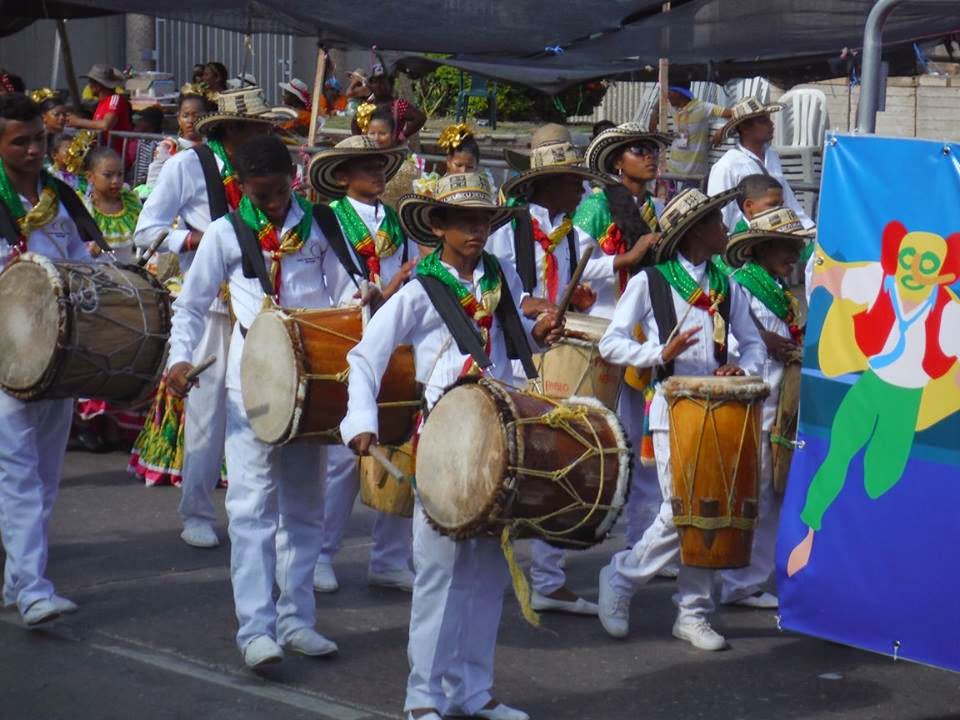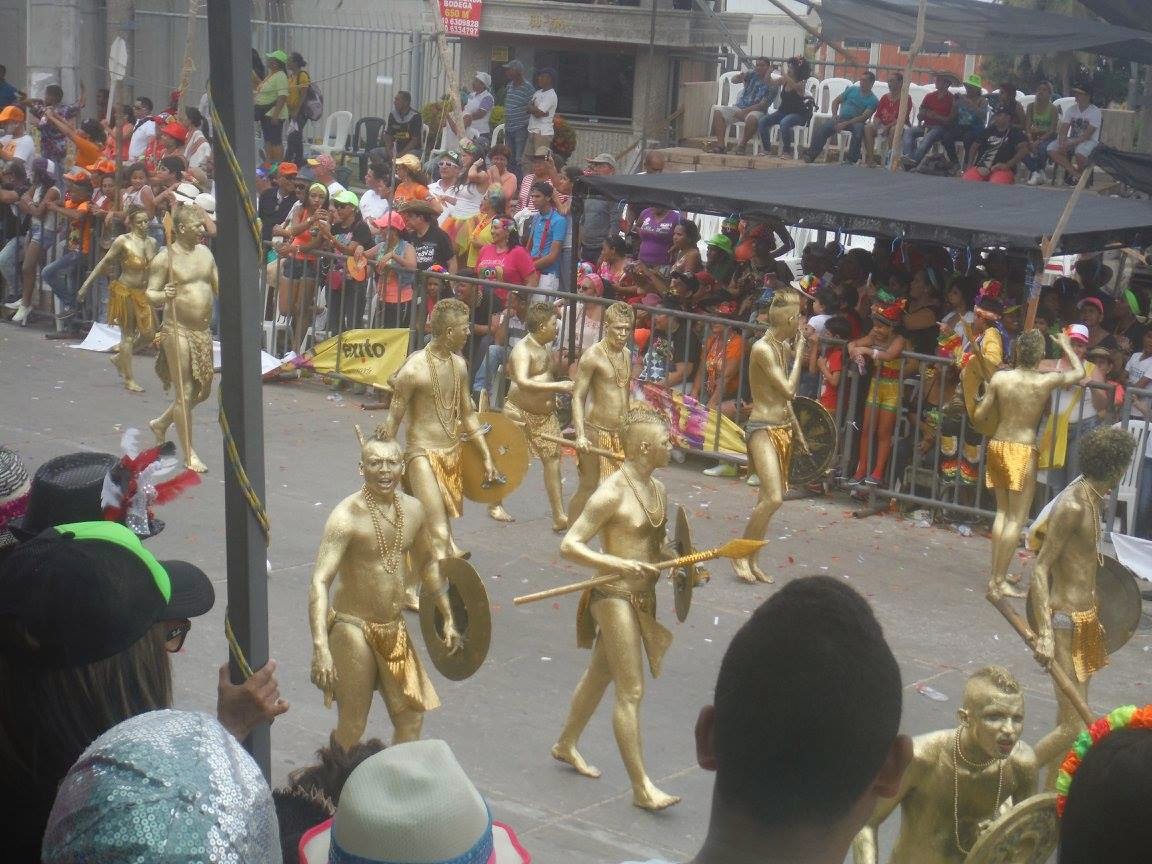Ever since the moment that we touched down here in Colombia,
the event that every single person we have run into has been about Carnaval.
The buzz and amount of pride that the residents have displayed in having the
world’s second largest Carnaval celebration in the world (smaller only than
that of Rio de Janeiro in Brazil) has been apparent for the last 5 months. As
soon as the calendar changed from 2014 to 2015, the focus shifted as well.
Storefronts started hanging streamers. Traditional characters were painted on
billiards halls. Special music created especially for the event flooded the
busses, streets, and clubs at night. The stage was set for the biggest event of
the year here on the coast!
This four day folkloric festival, which is always celebrated
starting on the Saturday before Ash Wednesday, is attended by over one million people
every year, including tourists from around the world. With traditions dating
back from the late 19th century, this celebration has been a staple
of life in Barranquilla for many years. The celebrations begin about a month
before the actual Carnaval itself. These Pre-Carnaval events are filled with
just as much excitement, as the entire town prepares itself for the
festivities.
Some of the Pre-Carnaval events include the following:
- Lectura del Bando: This event is highlighted by the traditional reading of the Carnaval declaration by the Queen. This declaration, which states that everyone must enjoy themselves by dancing and partying wildly, is the official start to the Carnaval season.
- La Guacherna: This nocturnal parade is the most important event of the Pre-Carnaval season. Held the second Friday before the start of Carnaval, this parade is filled with traditional performances by people dressed up as marimondas, monocucos, los Negros, cumbia dancers, los Congos, and other folkloric characters.
- Coronación de la Reina: This event, which occurs the Thursday before the first day of Carnaval, features tons of popular and famous musical artists. It also showcases the passing of the crown from the previous year’s queen to the current queen. This year’s musical acts included Mr. Black, Young F, Peter Manjarres, Twister El Rey, and other big name Latin artists.
These
events, and a slew of other, helped set the stage for the actual Carnaval event
itself. Back in January, Derek and I had bought tickets for the three big
parades. This tickets, which guaranteed us palcaos (stadium style seating set
up along the parade route) meant that we did not have to fight with the masses
for a good view of the parades as they passed through along Via 40.
The official festivities kicked off on Saturday, February 14th
with La Batalla de los Flores (Battle of the Flowers). This parade, which is
the most important event of Carnaval itself, is a traditional parade in every
sense of the word. It features floats, famous figures, and lots of performances
from various groups around the Atlántico region. The parade lasts about six
hours (we didn’t stay for the whole thing) and was a great way to kick off the
Carnaval season. Later that night, we met up with some other friends of ours
and headed over to La Troja, with is a super popular outdoor salsa club. The
streets around the club were closed off and were filled with people from all
over. After dancing there for a couple of hours, Derek and I headed to another
block party with some other friends from Peace Corps. This party featured
traditional Colombian music, played by live bands. It was once again an awesome
scene and we had tons of fun just soaking in the atmosphere.
Sunday brought along La Gran Parada (The Grand Parade). This parade was void of floats, but full of Colombian coastal culture. The groups that participate in this parade represent some form of folkloric Colombian character. The loud, booming speakers of the day before were replaced with smaller, live ensembles consisting of drums, trumpets, clarinets, and some traditional Colombian instruments. This parade really did a great job of highlighting the importance of these characters to the Colombian people themselves. There was a great sense of pride from the participants as they were able to showcase their culture. That night, Derek and I once again headed to La Troja, where we met up with some other volunteers and once again enjoyed a long night of dancing and music. While La Troja normally isn’t one of my favorite places to pass a night at, I will admit that being a part of the massive crowd was very entertaining.
Monday brought my favorite parade, Desfile de las Fantasias (The Fantasy Parade). This parade was filled with brightly colored costumes, invigorating beats, and captivating performances. Many of the costumes worn by the participants featured feathers, sequence, and in most cases, very little else. When one thinks of Carnaval, the participants of this parade would fit into what normally comes to mind. Local dance styles, like cumbia, champeta, and vallenato, are mixed with samba, salsa, and raggaeton to create a magical atmosphere that definitely pleased the spectators. To wrap up our Carnaval celebration, Derek and I inadvertently crashed a random birthday party to help support the band that one of the volunteers in our group is a member of. While we were definitely out of place and received some pretty strong stares, it was still a pretty good way to bring our first Colombian Carnaval to an end.
Throughout this post, I’ve alluded to some Colombian folkloric characters that made numerous appearances throughout the Carnaval season. Here is a bit more of an in-depth look at these characters and their meaning to the Colombian people:
Los Monocucos: Back before Barranquilla was the large, industrial city that it is today, rich men used to ride into town during Carnaval and try to woo the local women. However, they would hide their identities behind masks, which helped inspire the monocucos costume. Consisting of a jester-like robe, a hood, eye-mask, and long piece to cloth to cover the bottom half of the face, this costume allows for the wearer to easily remain hidden or reveal themselves if so desired.
Los Congos: This costume, which is one of the oldest of Carnaval, was inspired by the Congo region of Africa. Consisting of a large headdress adorned in brightly colored flowers, white painted faces with rosy red cheeks, sun glasses, and an intricate pant suit, the male participants definitely stand out in a crowd. The women dress themselves in brightly colored dresses that tend to match the color palette worn by the men. The men also tend to carry a machete in their right hand.
Los Negros: One of the neatest things about the entire Carnaval experience here on the coast is the fact that all aspects of the costal history are celebrated and shared – even those that may tend to cast a bit of a dark shadow on the area. Influenced by the visible African slave trade in the area (mainly Cartagena), Los Negros represent an important aspect of Colombia’s past. Thick, black body paint and sombreros adorned with brightly colored flowers that helped to protect the slaves against the strong coastal sun characterize these participants. The dance that is associated with Los Negros was created in Santa Lucia, a town in southern Atlantico. It is filled with tons of strong and rapid movements, along with exaggerated facial expressions, highlighted by bright red tongues and lips. It’s quite a startling sight to see when one of the participants unexpectedly invades your space!
Los Garabatos: This folkloric tradition highlights the constant struggle between life and death. Traditionally, costumes are made out of red, yellow, and green material (which are the colors of the Barranquilla flag). Males wear yellow shirts, a red and green cape, black pants, and tall white socks. To highlight their representation of life, white hats accompany faces that are painted white with red cheeks. Women wear long dresses that are comprised of the same colors (black, red, yellow, and green) along with a large flower in their hair. Someone wearing a skeleton outfit with a scythe also accompanies this tradition to represent death. During the course of the dance, one of the lead male Garabatos fights off death, showing the life triumphs over death every time.
La Cumbia: This is by far the most important and famous dance of the Colombian coast. This dance is influenced by the mixture of indigenous, African, and Spanish cultures during Colonial times. The instrumentation and songs represent this combination – drums (African), maracas and pitos (a flute-like instrument) (indigenous), songs (adapted from Spanish poets). The dance itself has a strong African influence – the women make short, quick movements which symbolize the chains that bound the feet of many slaves as they made their way from the ships to the market place. The dresses that the women wear are very reminiscent of the Spanish upper class during the Colonial time period. Men traditionally wear all white, accompanied by a red neckerchief and a hat. The presence of lit candles and balanced aguardiente bottles on the heads of the women make this one of the most entertaining dances on the coast!
Rey Momo: A part of the Carnaval celebrations since 1888, the King of Carnaval here in Barranquilla is adorned in all gold (including gold body paint), wears a massive nose ring (which makes him look like a boar on the farm), and is accompanied by a band of warriors. This character is traditionally a tall and fat man – a representation of the physical stature of the original Rey Momo.
La Reina de Carnaval: A part of the Carnaval celebrations since 1918, the Carnaval Queen is traditionally chosen at the end of the previous Carnaval to give her plenty of time to prepare for the festivities. The Queen is chosen by the committee that oversees the Carnaval festivities and is given the job of presiding over all events in relation with Carnaval.
Obviously, there are more characters and historical
components to the Carnaval celebration, but I’m going to stop there on account
of the fact that this post is getting rather lengthy! All in all, the build-up
and hype that accompanied did not disappoint. It was amazing how fast the whole
thing flew by! I’m excited for next year’s celebration already, as I will have
a better understanding of everything that’s happening. I’m also looking forward
to being able to get more involved at my school (since I’ll actually have one
during Carnaval next year) and am hoping to be named Rey Momo, which finally
learning how to properly dance the cumbia!
PS - check out the latest edition of Oiste, the Peace Corps Colombia quaterly newsletter to stay up to date on things happening here on the coast! Also, look for the article by yours truly regarding the recent moves that have taken place throughout the country.



























